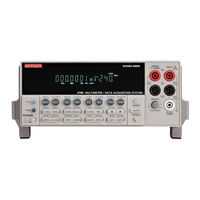
Keithley 2700 Manuals
Manuals and User Guides for Keithley 2700. We have 3 Keithley 2700 manuals available for free PDF download: User Manual, Service Manual, Quick Start Manual
Keithley 2700 User Manual (462 pages)
multimeter/switch system
Brand: Keithley
|
Category: Multimeter
|
Size: 2 MB
Table of Contents
-
-
Inspection32
-
Power-Up42
-
Display46
-
-
-
-
-
Connections71
-
Pseudocards72
-
-
-
-
Connections109
-
Crest Factor113
-
-
Shielding113
-
Thermal Emfs114
-
-
-
Thermocouples123
-
Thermistors125
-
4-Wire Rtds126
-
Connections126
-
-
-
Connections137
-
-
Fetch146
-
Limitations146
-
What It Does146
-
Limitations147
-
Read147
-
What It Does147
-
When Appropriate147
-
Limitations148
-
What It Does148
-
When Appropriate148
-
Examples149
-
-
-
-
Range
151-
Manual Ranging152
-
Auto Ranging152
-
Scanning152
-
-
-
-
Basic Operation171
-
Relative
171-
Scanning172
-
-
-
-
-
Rel Commands173
-
Commands173
-
-
Math176
-
MX+B177
-
MX+B Rel178
-
Percent178
-
Reciprocal (1/X)179
-
Basic Operation180
-
Scanning180
-
-
-
-
Basic Operation185
-
Scanning186
-
-
-
-
Buffer
192-
Buffer Overview193
-
-
Auto Clear193
-
Timestamps194
-
Storing Readings196
-
-
Average198
-
Peak-To-Peak198
-
-
-
-
Buffer Commands199
-
-
-
6 Buffer
200 -
Scanning
206-
-
Scan Process208
-
Trigger Models209
-
Control Sources212
-
Idle212
-
Delays213
-
Device Action214
-
Reading Count214
-
Output Trigger215
-
-
Scan Reset218
-
Simple Scan219
-
Advanced Scan220
-
Setting Delay223
-
Monitor Channel223
-
Saving Setup226
-
Auto Scan226
-
Scan Operation227
-
-
Trigger Model231
-
Channel Setup232
-
Buffer232
-
-
-
7 Scanning
233 -
Triggering
244-
Trigger Model245
-
Idle245
-
Device Action248
-
Output Trigger248
-
-
-
8 Triggering
247-
-
Hold Example249
-
Beeper Control249
-
-
-
-
-
Limits263
-
Figure264
-
-
Beeper Settings265
-
Setting Limits265
-
-
Scanning265
-
Digital I/O266
-
Digital Outputs267
-
Scanning273
-
-
-
-
Pseudocards281
-
Autozero281
-
Db Calculation281
-
-
GPIB Setup283
-
GPIB Standards283
-
-
-
-
LOCAL Key290
-
-
Command Words290
-
Query Commands292
-
Case Sensitivity292
-
Short-Form Rules293
-
Program Messages294
-
-
Status Structure
302 -
-
-
Figure307
-
-
-
Event Registers318
-
Queues320
-
-
Common Commands
322 -
-
Reference Tables347
-
-
-
-
Screw Terminals388
-
Wiring Procedure389
-
Figure391
-
Connection Log393
-
-
-
-
-
-
Fetch413
-
Read413
-
Calc3:Lim1:Fail414
-
Calc3:Lim2:Fail414
-
Measure?414
-
Trace:data414
-
Calc2:Data415
-
Calc2:IMM415
-
Scanning416
-
Advertisement
Keithley 2700 Service Manual (174 pages)
Data Acquisition System
Brand: Keithley
|
Category: Multimeter
|
Size: 3 MB
Table of Contents
-
-
Introduction18
-
-
-
-
-
Introduction50
-
-
Line Power50
-
-
-
-
-
Introduction74
-
-
-
Introduction82
-
-
-
-
Introduction100
-
-
Solder Repairs100
-
-
-
Parts Lists108
-
Factory Service108
-
-
DC Volts124
-
DC Current124
-
Ac Current125
-
-
Specifications
132 -
-
Introduction138
-
Command Summary138
-
-
Ac:step<N150
-
-
Ac:step<14|15151
-
DC:step0151
-
-
-
Keithley 2700 Quick Start Manual (52 pages)
Brand: Keithley
|
Category: Data Loggers
|
Size: 1 MB
Table of Contents
-
Buffer
38
Advertisement


